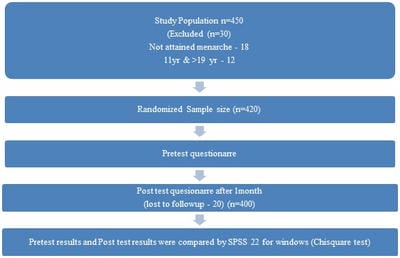Assessment of knowledge and practice of menstrual hygiene among adolescent girls of government school of Jabalpur and impact of health education on menstrual hygiene
Singh P.1*, Lazarus M.2, Priyadarshini S.3
DOI: https://doi.org/10.17511/ijpr.2021.i04.06
1* Preeti Singh, Senior resident, Department of Pediatrics, Netaji Subhash Chandra Bose Medical College, Jabalpur, Madhya Pradesh, India.
2 Monica Lazarus, Associate professor, Department of Pediatrics, Netaji Subhash Chandra Bose Medical College, Jabalpur, Madhya Pradesh, India.
3 Priyadarshini S, Senior Resident, Netaji Subhash Chandra Bose Medical College, Jabalpur, Madhya Pradesh, India.
Introduction: India is a developing country, it has made advancements in every field, but still menstruation is a topic of social taboo in many rural and suburban parts of the country, as people feel shy and difficult to discuss it openly, even mothers, sisters and teachers are not able to provide correct information regarding menstruation physiology and its hygiene. Objective: To educate adolescent girls and assess the impact of health education on them. Methods: About 400 adolescent girls aged 11-19 years from 3 government schools of Jabalpur were interviewed using a pretested and predesigned questionnaire in the local language. Health education regarding hygienic practices during menstruation was given through audiovisual aids after filling out the questionnaire. Results: out of 400 girls,291(72%) girls already knew that menstruation is a physiological process which increased significantly to 307(76.8%). Knowledge was poor about the source and type of bleed; only 99 (24.8%) knew that the original was the uterus. Only 59(14.8%)girls were using sanitary napkins. In contrast, most of them were using old cloth265(66.3%)of which 86.3% were washing it with soap and water, and 67.3% used to dry them inside their houses, which increased significantly after imparting health education to 99%and decreased to 6% respectively. Conclusion: The result of this study indicates that there is a need for the establishment of a comprehensive school health education programme with solid familial input. Teachers should be trained to provide health education about menstruation, its physiology and correct hygienic practices, as the adolescent girls will turn into mothers one day.
Keywords: Adolescence, Menstruation, Health education, Menstrual hygiene, Reproductive tract infection
| Corresponding Author | How to Cite this Article | To Browse |
|---|---|---|
| , Senior resident, Department of Pediatrics, Netaji Subhash Chandra Bose Medical College, Jabalpur, Madhya Pradesh, India. Email: |
Preeti Singh, Monica Lazarus, Priyadarshini S, Assessment of knowledge and practice of menstrual hygiene among adolescent girls of government school of Jabalpur and impact of health education on menstrual hygiene. Pediatric Rev Int J Pediatr Res. 2021;8(4):201-206.
Available From https://pediatrics.medresearch.in/index.php/ijpr/article/view/661 |


 ©
© 